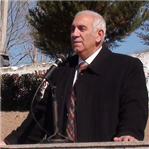
Hakob Yervand Simonyan
Dr./Prof. Hakob Yervand Simonyan is one of the deans of Armenian Archaeology, having won the Armenian metal for lifetime achievement in recent years. He has broad experience in Armenian archaeology at sites like Nerkin and Verin Naver, Karmir Blur, Aghdzq, Agarak, Shengavit, etc. He has edited the Hrazhdan journal. He has written 230 articles on aspects of the Armenian past from the Bronze Age to the early kings of Armenia. He is a professor of Art History at the Yerevan State University, but most of his time when not doing archaeology he spent to administer the Department of Archeology of the Scientific Research Center for Historical & Cultural Heritage, Ministry of Culture, Republic of Armenia.

Mitchell Rothman
Dr. Mitchell S Rothman is an Emeritus Professor of Anthropology and Archaeology at Widener University, and a Consulting Scholar at the Penn Museum. He has conducted archaeological excavation and survey projects throughout the Middle East. He has written final reports on earlier excavations at Tepe Gawra, Iraq, and Godin Tepe, Iran, and books and articles on the origin of the state in Mesopotamia of the Uruk Period, the Kura-Araxes cultural tradition, and theoretical issues of archaeological interpretation. His early work concentrated on Mesopotamia, but in the last decade and a half he has been involved with understanding the fascinating 4th and 3rd millennium BC Kura-Araxes culture in its South Caucasian homeland and in its extensive migrant diaspora from the Zagros across the Taurus Mountains and down into the Levant.
Introduction to Chapters
Mitchell Rothman
Chapter 1. Background
History of Shengavit Excavations, Anthropological Problems and Background.
Hakob Simonyan and Mitchell Rothman
Chapter 2. Environmental Background and Geology
Mitchell Rothman
Pollen reports
Elisio Kvavadze and Anahit Atoyants
Chapter 3. Stratigraphy of Shengavit
a. 2000-2008
Hakob Simonyan
b. 2009-2012
Mitchell Rothman
Chapter 4. Architectural Remains
a. History of Shengavitian Architecture
Gregory Areshian
b. Houses and House Types at Shengavit
Hakob Simoyan, Hovannes Sanamyan
c. Georadar
Mikayel Gregoryan and Raffie Duragyan
Chapter 5. Economic Activities
a. Animal utilization
Pam Crabtree, Jennifer Piro (with notes by H.-P. and M. Uerpmann and Nyree Manoukian)
b. Plant utilization
Roman Hovsepyan
c. Lithics
Dan Rahimi
d. Metallurgy, Objects of Metal
Khachetur Meliksetian
e. Ceramics
Mitchell Rothman
f. Ground Stone Tools
Mitchell Rothman
g. Bone Tools
Mitchell Rothman
h. Jewelry
Hakob Simonyan
Chapter 6. Ritual and Ideology
a. Ritual and Group Integration
Mitchell Rothman, Hakob Simonyan
b. Mortuary Practice and Tombs
Hakob Simonyan
c. Figurines
Hakob Simonyan
Chapter 7. Synthesis and Future Questions
Hakob Simonyan and Mitchell Rothman
Sources of Images in Figures
Index
******************
Chapter authors:
Dr. Gregory Areshian is another Dean of Armenian archaeology and languages, who sadly died from Covid-19 in 2020, and to whom we dedicate the volume. He was a professor at UC Berkley and more recently the American University in Yerevan. He was an archaeologist at many digs in Armenia, was Hakob Simonyan’s teacher, and has written voluminously on topics about Armenian from prehistory to Medieval times.
Dr. Pam Crabtree is a professor in the Anthropology department at NYU. She is a world renown palaeozoologist and has worked on animal bone remains from sites in England, Ireland, the Middle East, and Hawaii. She is the author of many reports on her zoological research, this one with a former student, Dr. Jennifer Piro.
Dr. Khatchetur Meliksetiyan is a metallurgist trained in Germany with Dr. Ernest Pernicka, with whom he co-authors this chapter on the metal remains from Shengavit. He has written many articles on his metallurgical research. He is currently the Director of the Republic of Armenia Institute of Archaeology and Ethnography, Yerevan State University.
Dan Rahimi is a specialist on lithic (chipped stone) materials. Early in his career he participated in many digs in Jordan, Israel, and Turkey. He has spent much of his time as Director of Collections and Exhibits at the Royal Ontario Museum in Toronto, and the Vice President of Collections and Exhibits at the Penn Museum. He was on the Shengavit crew in 2009 and 2010. In retirement he has returned, thankfully, to his area of expertise to do this chapter.
Dr. Roman Hovsepyan is a young, but highly regarded, ethnobotanist, who works at the Republic of Armenia Institute of Archaeology and Ethnography, Yerevan State University. He has done work on the plant remains from a number of Armenian sites, studied the plant use of modern highland populations, and had post-doctoral fellowships in France and elsewhere. He has published extensively on the plants of the Kura-Araxes period.
Dr. Elisio Kvavadze is a world-renown expert on palynology. She works at the Georgian National Academy of Sciences in the Institute of Palaeobotany in Tblisi. She in cooperation with other international scholars has re-written the climatology of the ancient Caucasian region. She writes this article with a plant geneticist from Yerevan state University, Anahit Ayotants.
Dr. Mikayel Gevorgian and Dr. Raffie Duragyan are from the Department of Geology and Geo-physics at Yerevan State University. They are trained in the techniques of georadar survey, which we found most useful in locating probable places to dig and to explore features of the site like its town wall.
Dr. Nyree Manoukian completed her PhD in Archaeological Science from the University of Oxford. She analyzed pottery from Shengavit using a multi-analytical approach through petrography, organic residue analysis, and compound-specific isotopic analysis.
Hovannes Samanyan is the architect for the Department of Archeology of the Scientific Research Center for Historical & Cultural Heritage. He was a regular on site during our excavations drawing architectural remains and sections (schematic drawing of the stratigraphy from the sides of excavated squares).